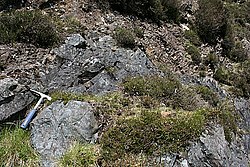
Porcellanite or porcelanite, is a hard, dense rock somewhat similar in appearance to unglazed porcelain. It is often an impure variety of chert containing clay and calcareous matter. [1]
Locations where Porcellanite has been found include Northern Ireland, Poland and the Czech Republic. Porcellanite is also commonly found in the Northern Territory of Australia. There, it comes in a variety of colours, primarily white, yellow, red and purple.

